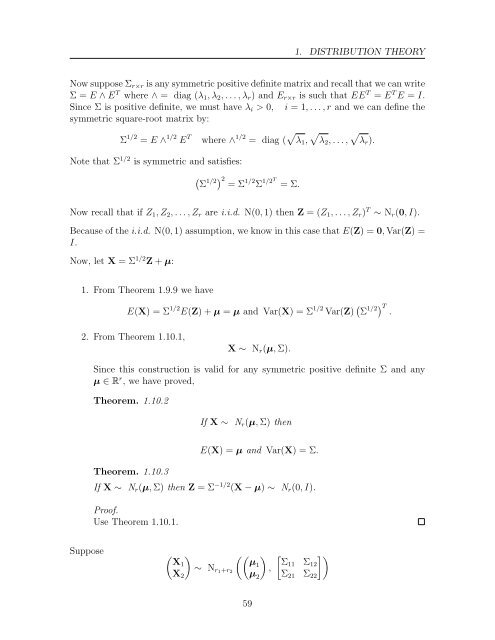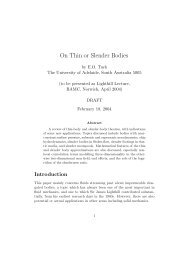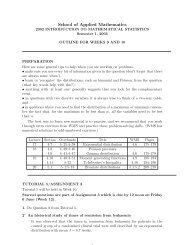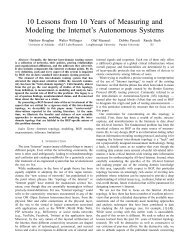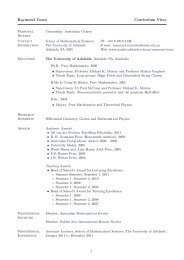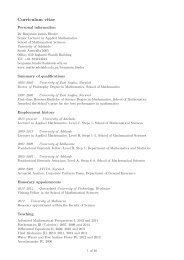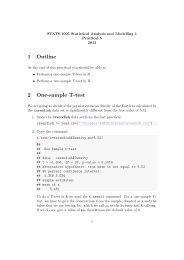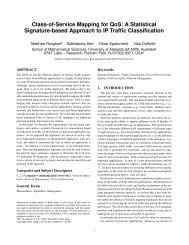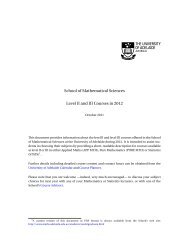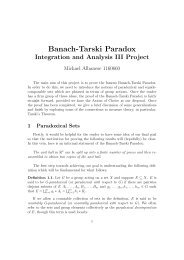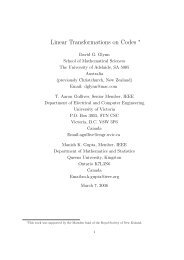PDF of Lecture Notes - School of Mathematical Sciences
PDF of Lecture Notes - School of Mathematical Sciences
PDF of Lecture Notes - School of Mathematical Sciences
You also want an ePaper? Increase the reach of your titles
YUMPU automatically turns print PDFs into web optimized ePapers that Google loves.
1. DISTRIBUTION THEORY<br />
Now suppose Σ r×r is any symmetric positive definite matrix and recall that we can write<br />
Σ = E ∧ E T where ∧ = diag (λ 1 , λ 2 , . . . , λ r ) and E r×r is such that EE T = E T E = I.<br />
Since Σ is positive definite, we must have λ i > 0, i = 1, . . . , r and we can define the<br />
symmetric square-root matrix by:<br />
Σ 1/2 = E ∧ 1/2 E T where ∧ 1/2 = diag ( √ λ 1 , √ λ 2 , . . . , √ λ r ).<br />
Note that Σ 1/2 is symmetric and satisfies:<br />
( ) Σ<br />
1/2 2<br />
= Σ 1/2 Σ 1/2T = Σ.<br />
Now recall that if Z 1 , Z 2 , . . . , Z r are i.i.d. N(0, 1) then Z = (Z 1 , . . . , Z r ) T ∼ N r (0, I).<br />
Because <strong>of</strong> the i.i.d. N(0, 1) assumption, we know in this case that E(Z) = 0, Var(Z) =<br />
I.<br />
Now, let X = Σ 1/2 Z + µ:<br />
1. From Theorem 1.9.9 we have<br />
E(X) = Σ 1/2 E(Z) + µ = µ and Var(X) = Σ 1/2 Var(Z) ( Σ 1/2) T<br />
.<br />
2. From Theorem 1.10.1,<br />
X ∼ N r (µ, Σ).<br />
Since this construction is valid for any symmetric positive definite Σ and any<br />
µ ∈ R r , we have proved,<br />
Theorem. 1.10.2<br />
If X ∼ N r (µ, Σ) then<br />
Theorem. 1.10.3<br />
E(X) = µ and Var(X) = Σ.<br />
If X ∼ N r (µ, Σ) then Z = Σ −1/2 (X − µ) ∼ N r (0, I).<br />
Pro<strong>of</strong>.<br />
Use Theorem 1.10.1.<br />
Suppose<br />
(<br />
X1<br />
X 2<br />
)<br />
∼ N r1 +r 2<br />
((<br />
µ1<br />
µ 2<br />
)<br />
,<br />
[ ])<br />
Σ11 Σ 12<br />
Σ 21 Σ 22<br />
59


